Bibliographic Supplement
the original edition of Baudelaire's Fleurs du Mal
The original edition of this major work of French poetry is a bibliophile parts most universally popular and therefore more difficult to acquire. This was the case upon its release, as revealed in a note on the copy of Chicken-Malassis specifying that the price of Holland had increased sixfold in just months.
Like a few other landmarks in the literature, the importance of the summit of poetry led fans - in search of the original condition of the work - to be interested in the complex editorial adventure of his first release.
If a remarkable bibliographic work has been done on the subject, it would be wrong to believe that the issue is finally closed.
It is still complicated to understand all the nuances that characterize the stages of printing of the first edition of Les Fleurs du Mal.
We propose to the attention of scholars and bibliophiles new bibliographic information that will distinguish it from other states as defined until now.
***
- Current state basic bibliographic knowledge
The original edition of Flowers of Evil was printed in 1857 in Chicken-Malassis and Broise From 1300 vellum copies of Angoulême, at least 200 have been redacted six parts following the trial of a chicken-and Baudelaire Malassis for "gross indecency and public morality."
Parts Sentenced Flowers of Evil by Charles Baudelaire: Lesbos. Damned women. - Delphine and Hippolyte. Lethe. At one which is too gay. Jewelry. The Metamorphoses of the Vampire.
They were cut directly in the copies in print. There are no new impression.
He was also fired 20 copies on Holland paper, most autographed by Baudelaire.
A small unknown number of copies was printed on the date of 1858 (but probably along with the other copies).
. Body text The draw of the original edition this typographical errors which are often described as characteristic of the first draw, although they are in fact common to the entire run:
- "Feurs evil" on pages 31 and 108:

- Pagination error p. 45 marked 44:

- Several mistakes in the text that Baudelaire discoveries As the draw and has corrected to hand over some precious copies.
It was detected hitherto only variation being draw, regarding the misprint "emboldened" to "emboldened". Corrected almost immediately, this shell remains only in a tiny number.
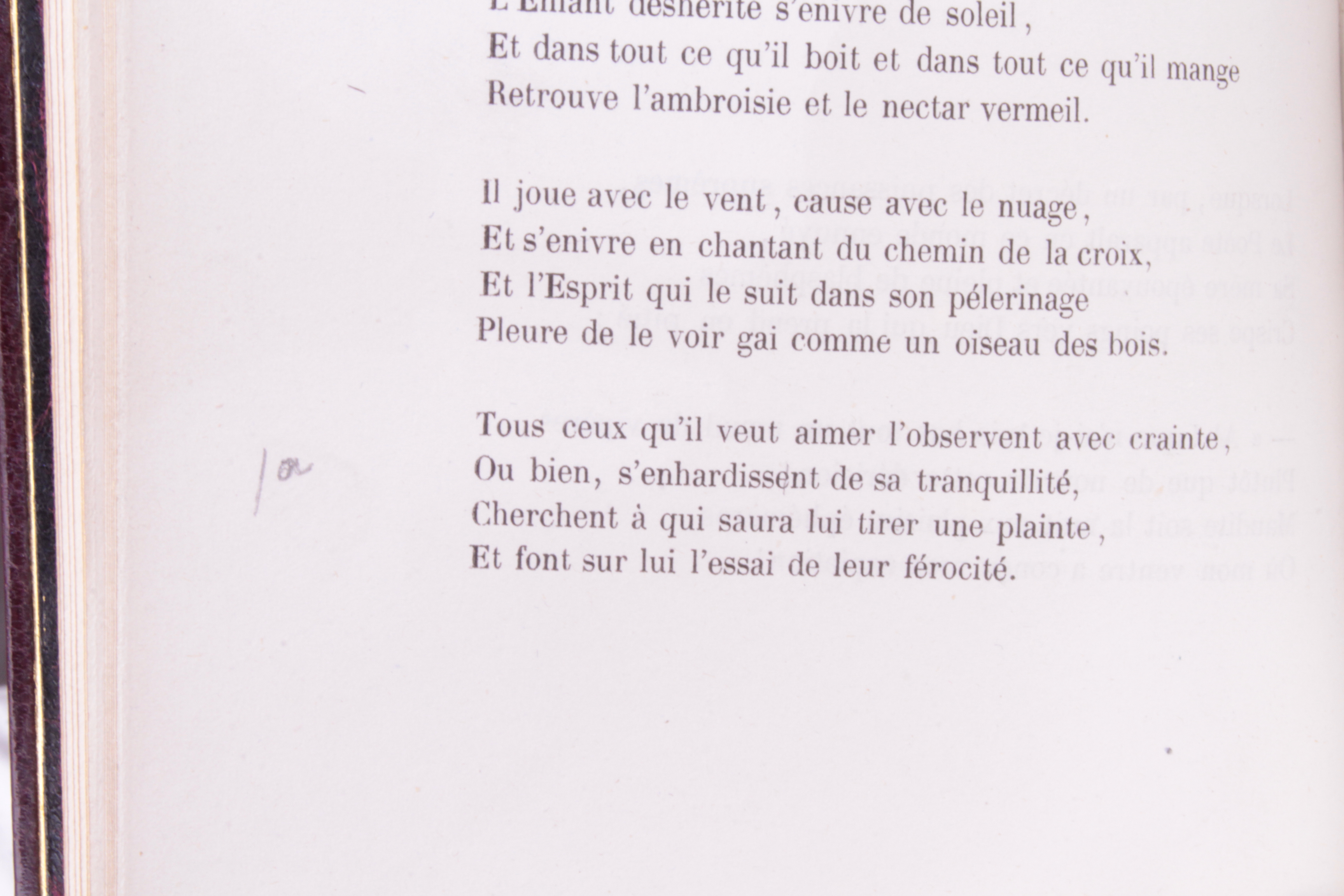 |
 |
Blame "emboldened" corrected
hand by Baudelaire |
Current draw with copy
shell "emboldened" corrected |
It is, as usual, in pencil, Baudelaire immediately corrected this shell on the first copies he had in hand, before changing printing.
This shell, absent corrected proofs stored at the BN, is the fact that printers who added this first book numerous errors most of which were notified before printing Baudelaire, as evidenced by several letters to Poulet-Malassis: "I just receive the first sheet. I hope she is not drawn because your workers will have introduced new offenses, such as points fists, etc. "(April 4, 1857) (" Definitely do not correct a sheet before I send it. This only serves to introduce mistakes "(14 May 1857)
Blame "emboldened" had to escape, initially, his vigilance and was not corrected until after the beginning of the draw.
. Louis
covers Carteret, and after him Robert Desprechins distinguished four states blankets, from which they deducted a chronology:
- 1st state: the price is back to 5 francs instead of 3 francs. On the second course, "Henry" instead of "Henry" of the Madeleine. Dates of Jean de Schelandre are "1385-1636" instead of "1585-1636". The price of the
History of the
sonnet is not round and angular characters. The "f"
Odes funambulesques consists in capital and not in small capitals.
"Olympus" is spelled "Olymphe".
- 2nd condition: Similar faults price of 3 francs.
- 3rd condition: without the mistakes of the first and second state.
- The fourth state is a total redesign of the second course, which includes four paragraphs and includes the announcement of the
Flowers of Evil in the "Modern Library".
- Carteret states that on the back of copies on Holland the price is 6 francs without specifying the status of the second course of these copies. This is actually the "third state" as you can see on the scanned copy of the BN.
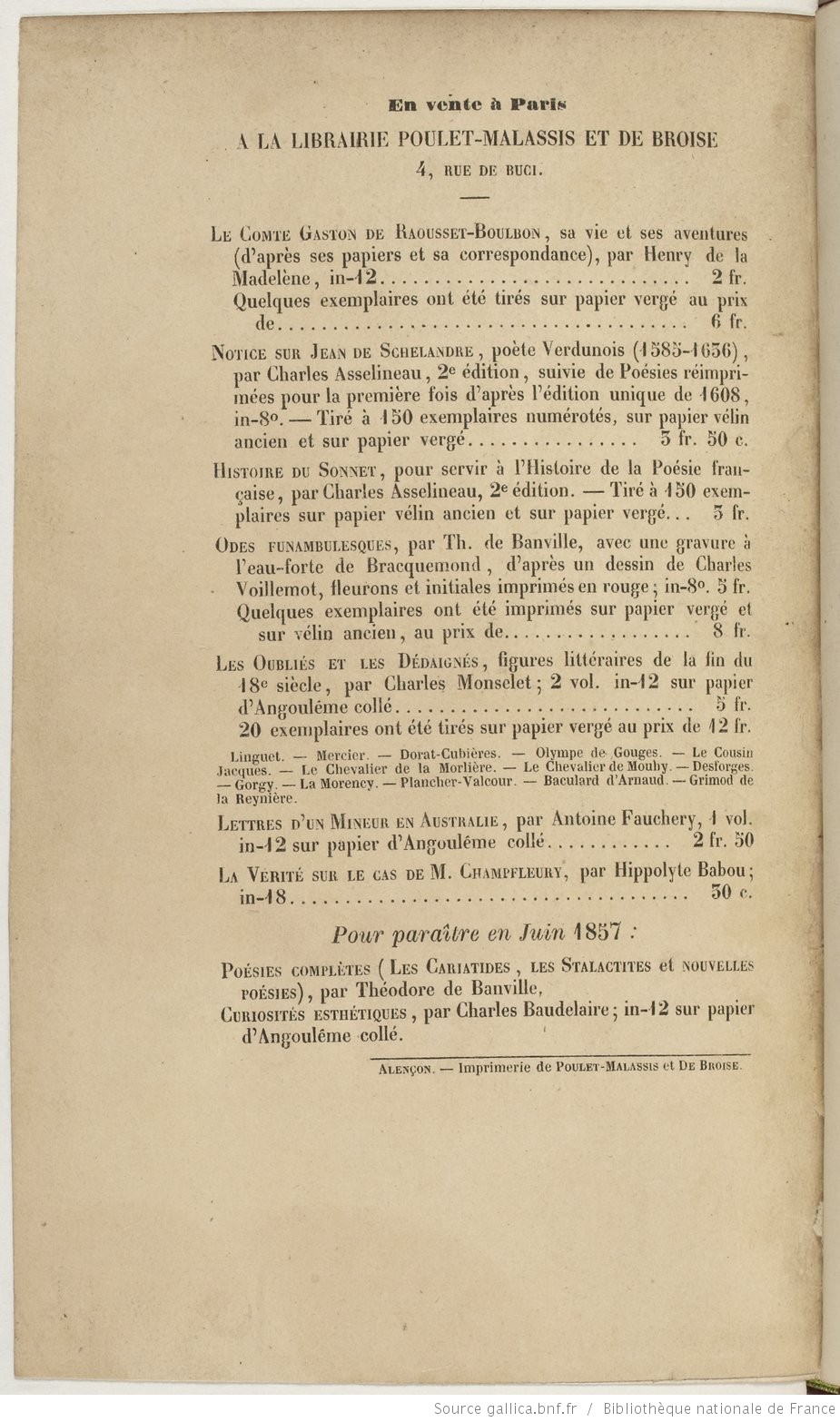 |
Second cover plate
copy Pincebourde |
Carteret also mentions that copies on laid are larger than those on plain paper (195 mm 184 mm instead). However in the current paper copies we possess - that are connected - the pages and covers measure 189 mm.
These are the bibliographic elements that have been previously identified to differentiate the states of the original edition of
the evil of Baudelaire
Flowers.
Body text. Bibliographers usually announce the correction of "emboldened" the only performed during printing.
Now it appears that some copies, including those of the first draw, have other features that do not appear on most of the 1,300 copies of the original edition.
Thus,
the back of the half-title page, for example four elements present in the first print copy of which we have worked will disappear successively during the draw:
 |
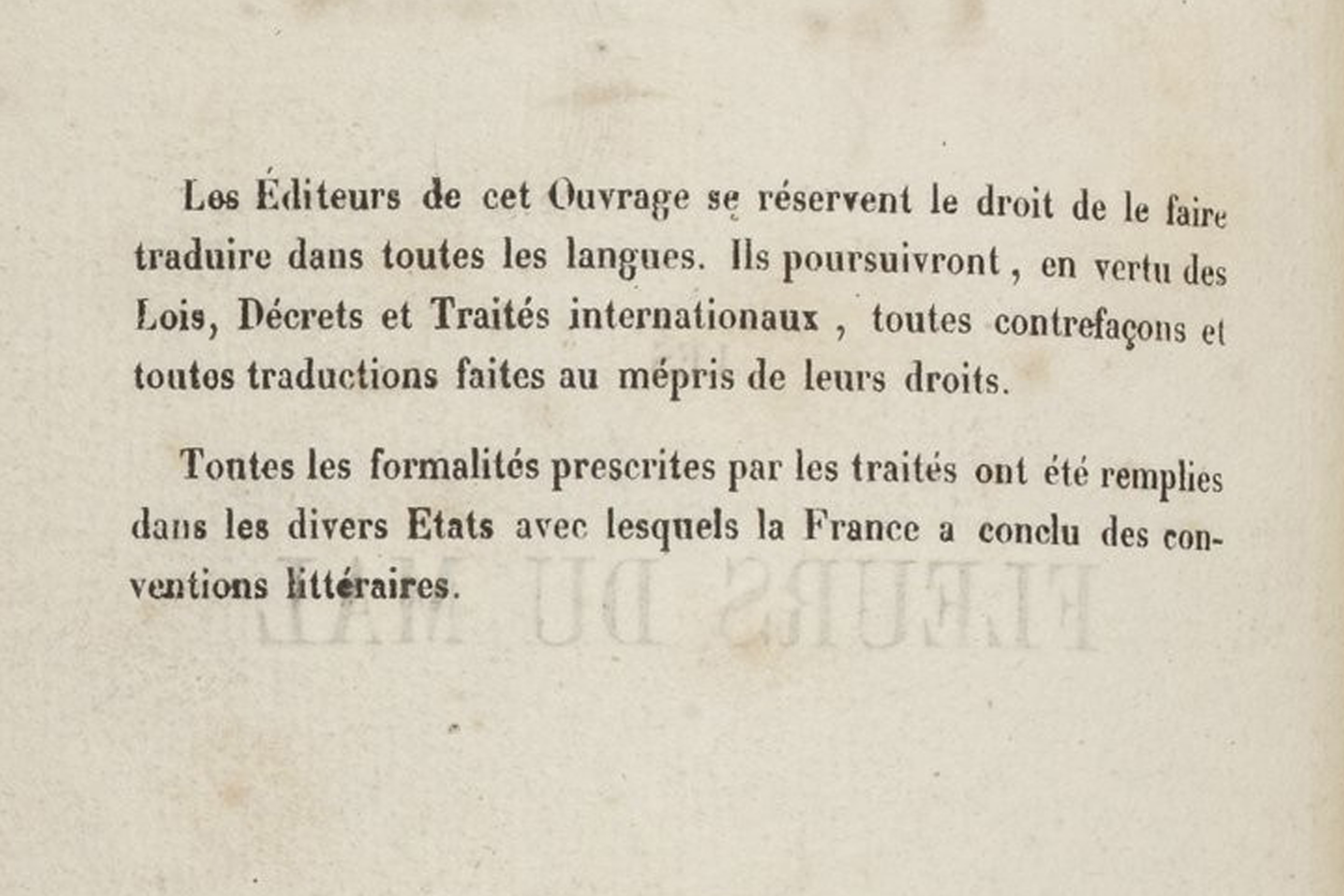 |
Warning of copy
First draw |
warning
copy Pincebourde |
- "The Editors" has a focus on "E".
- A space separates "They continue" the comma that follows it.
- "All counterfeits and all translations" later became "all counterfeits and translations."
- "Treaties" does not yet capital.
Typographical corrections will not appear all at once. And some copies have all of these features except the space before the comma, others are fully corrected but this space has reappeared and another space is added after "the Acts" (which homogenizes the typographical charter of the page).
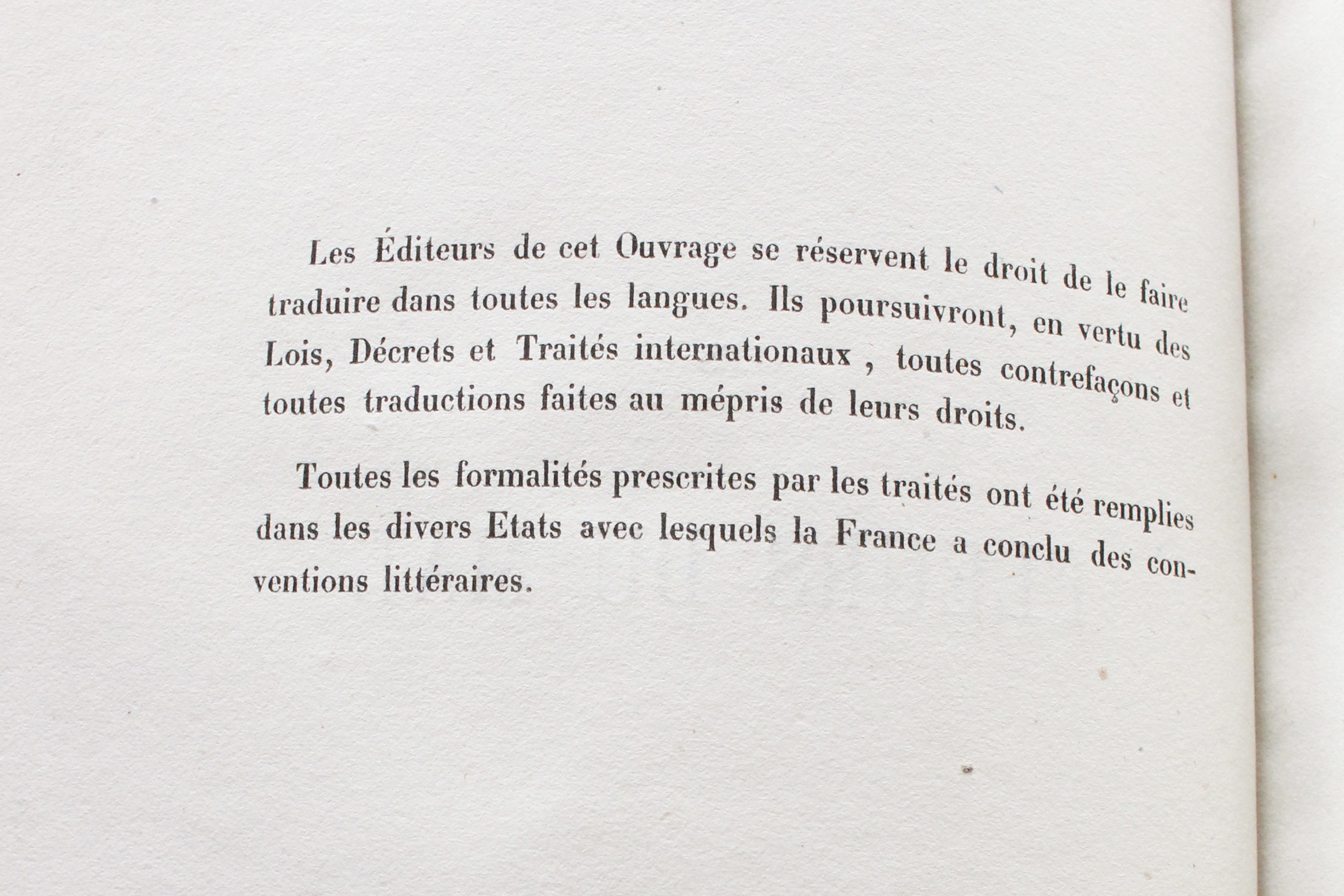 |
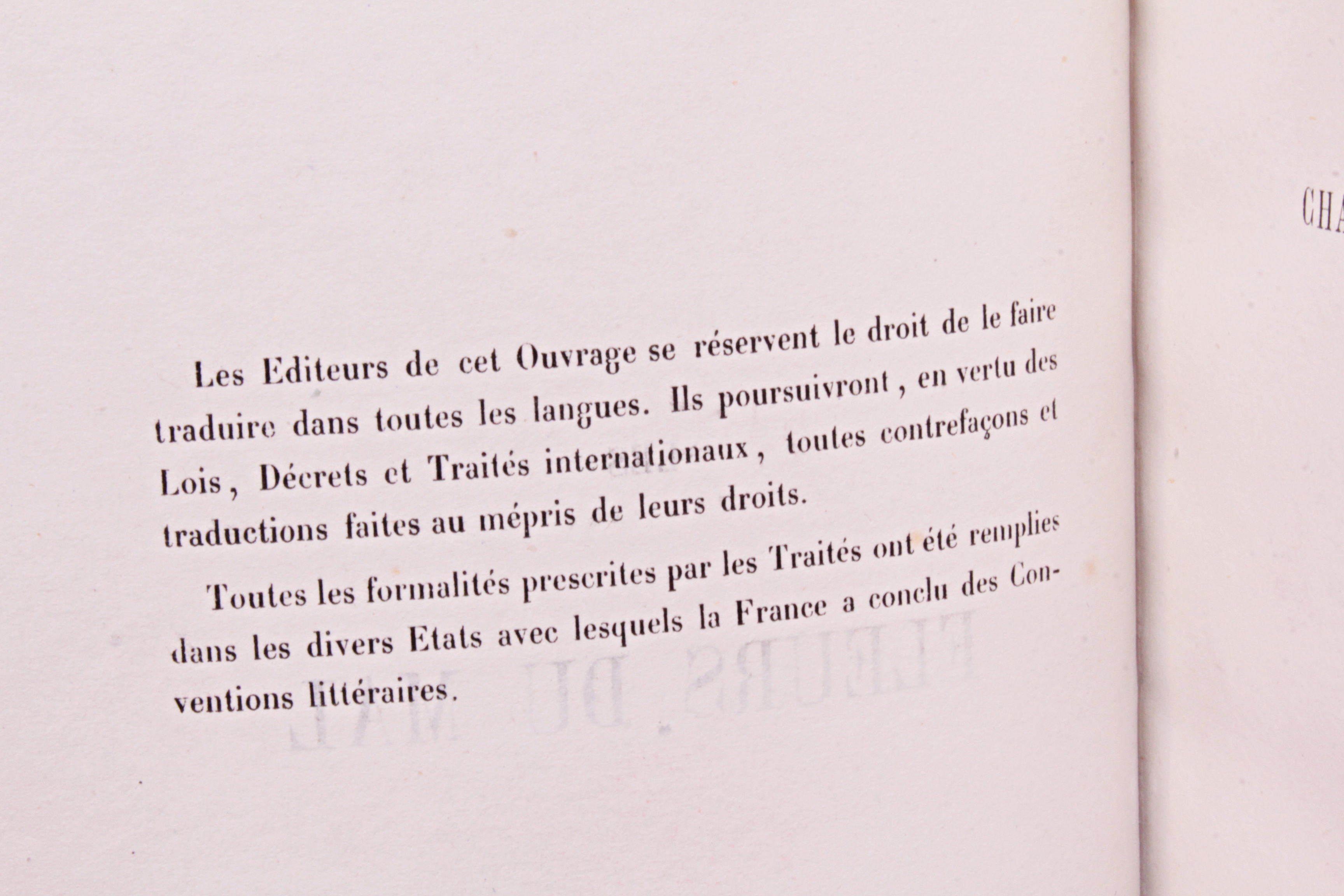 |
Early status
bug warning |
warning with
corrected mistakes |
Similarly,
the title page has several more or less distinct variants:
- The lack of development and closing parenthesis after
"The Tragic s, b. II "that characterizes our copy will be corrected on most copies.
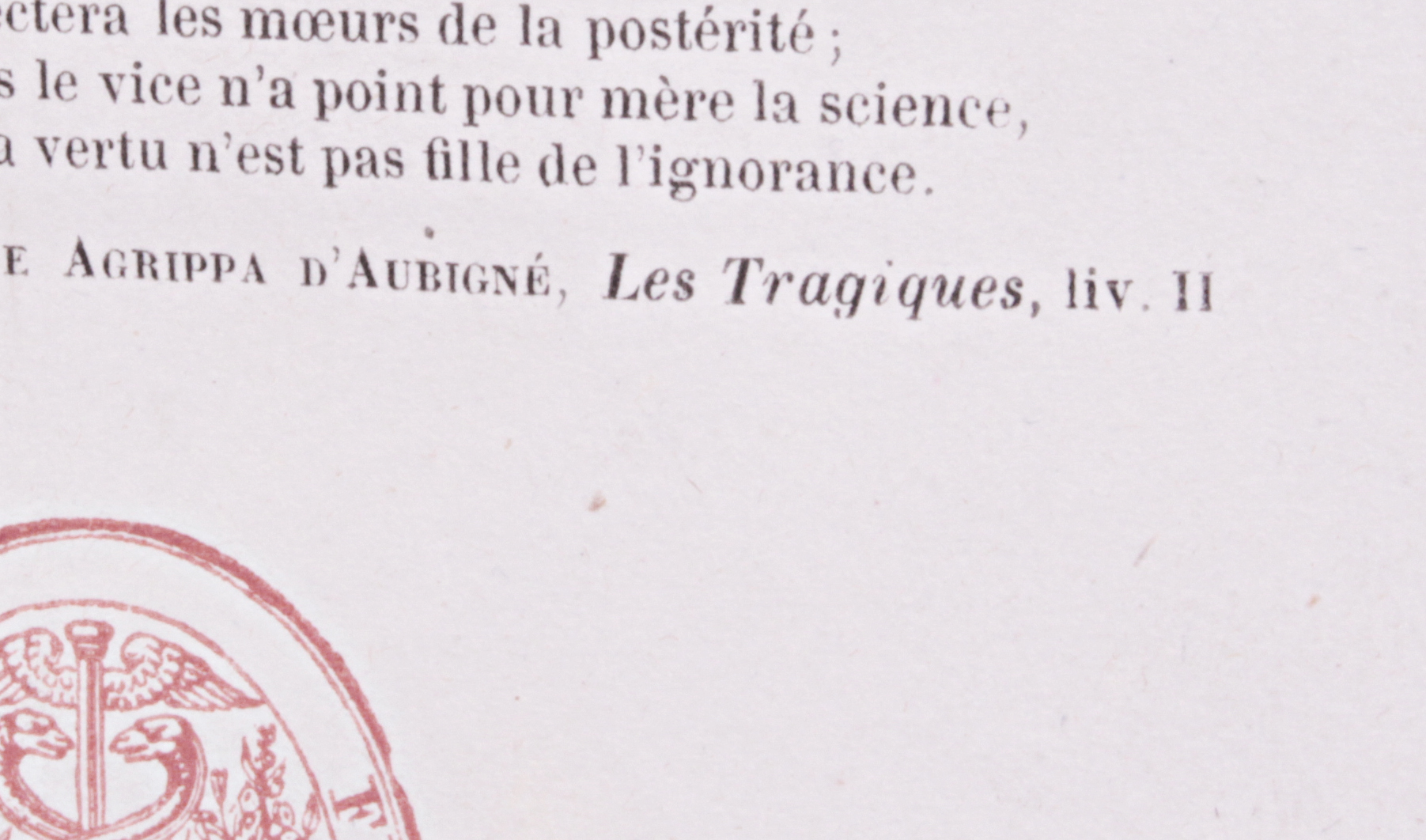
- The space between the "4" and comma of the Chicken-Malassis address is not present on the first draw, but appear independently of the previous correction on other copies.
- Finally the approach (character spacing) of the publisher's name differs depending on title pages. On the first draw, the words "Chicken-Malassis and De Broise" extends over 4.6 cm while in the following draws occupies 4.8 cm.
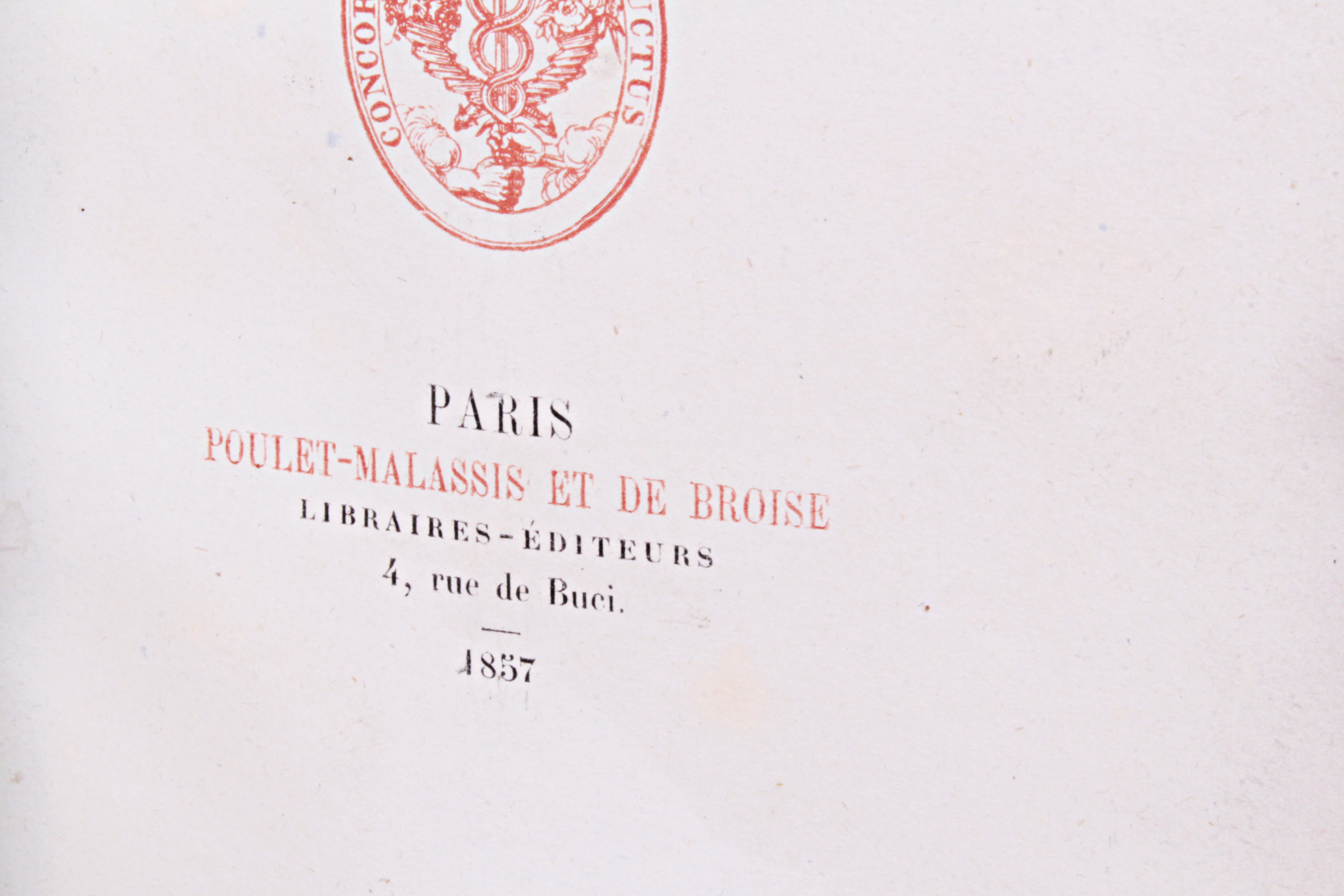
The other copies that we could see not exhibit homogeneity corrections, and there is many statements of the title page with one or more fixes.
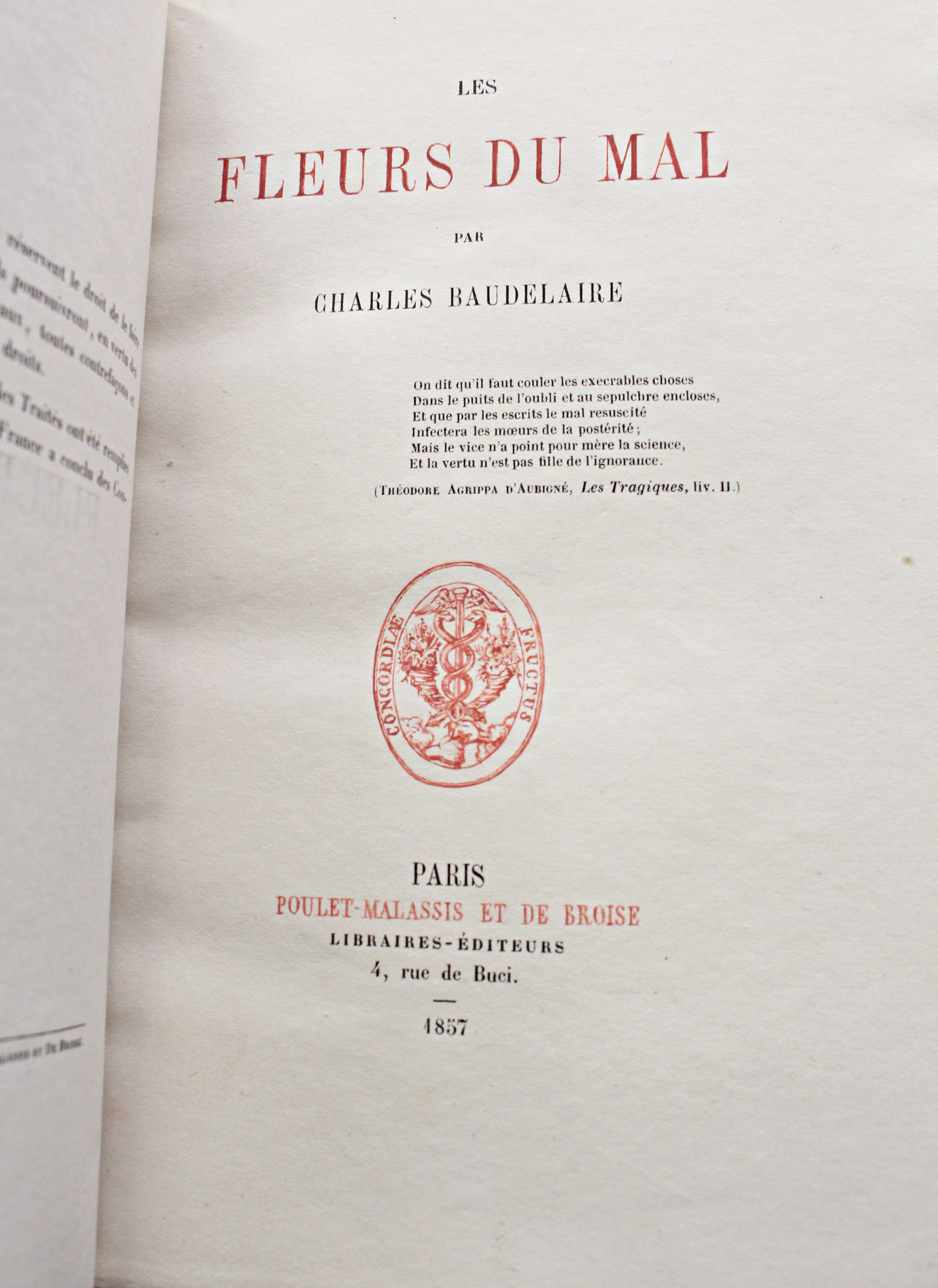 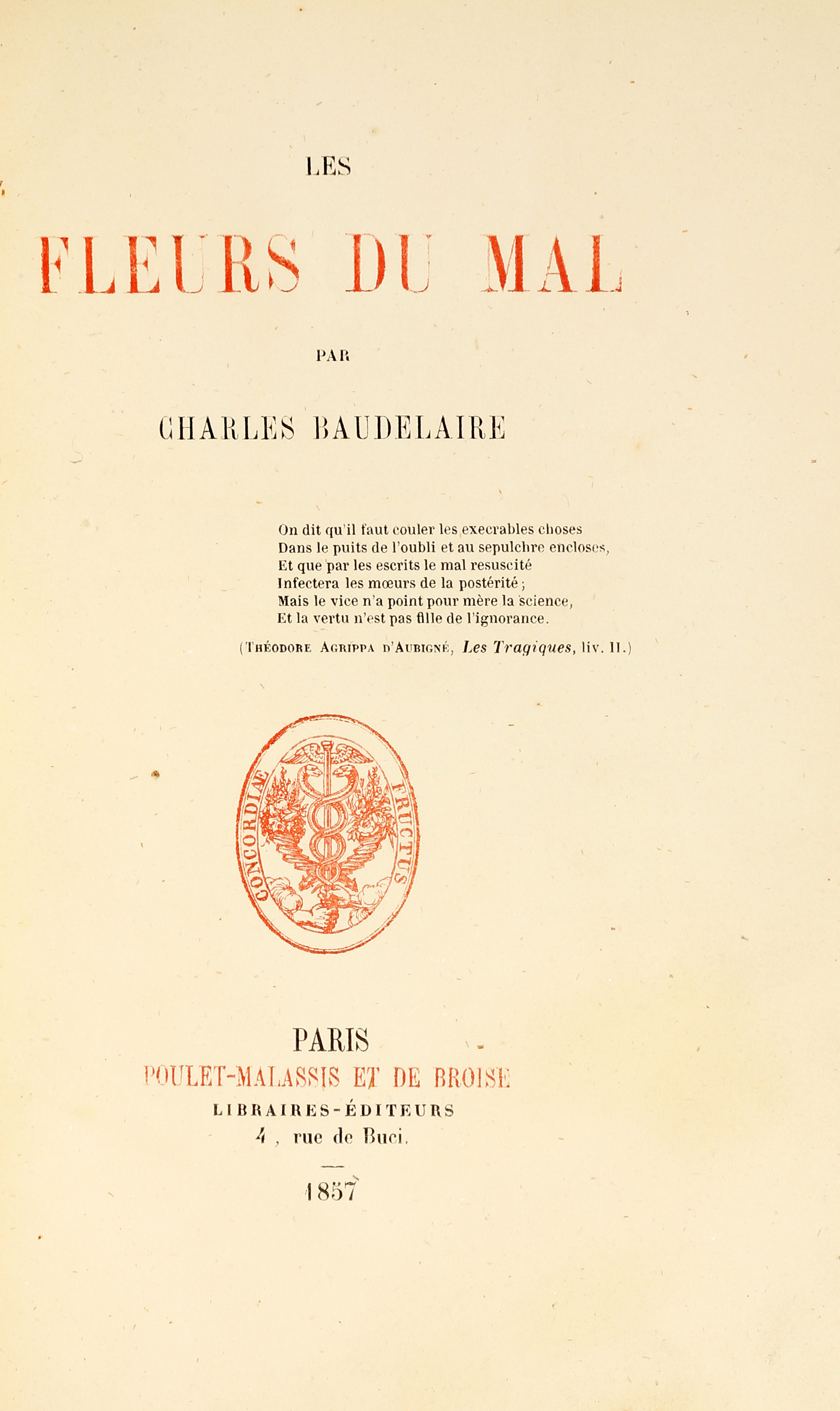 |
| Current print copies |
A complex inventory of these changes remains to be undertaken. Note that only copy in Holland we consulted describes the typographic features of our specimen with the exception of the fault "emboldened".
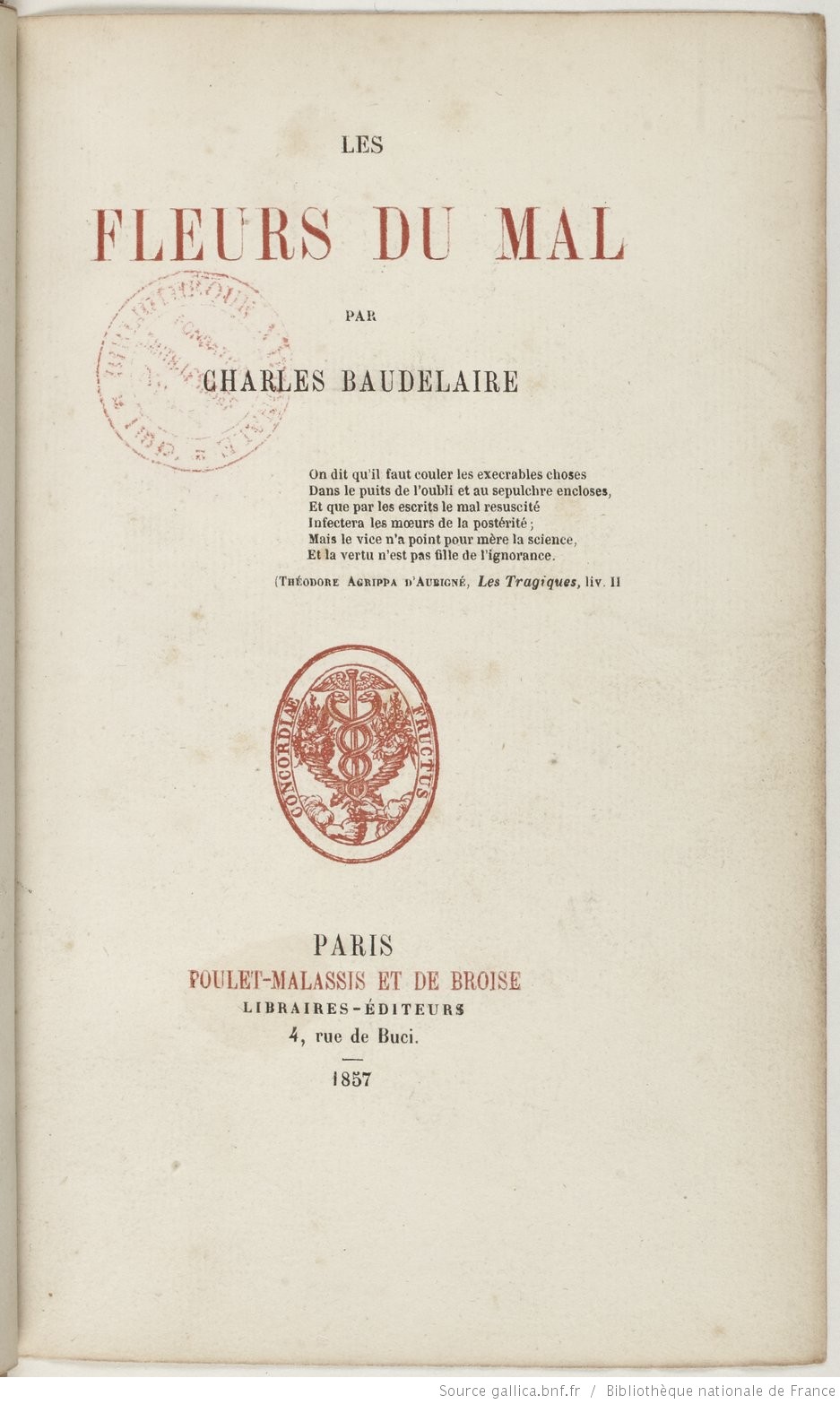 . Blankets
. Blankets blankets also have other differences than those found among other Carteret
On
the second course, plus five fouls already mentioned, there is in the second state of the features that are missing in the third.
- Brackets that frame "according to his papers and his correspondence", line 2, are separated from their content by a space
- Circumflex accent on "numbered", line 9
- No space between the dot and dash line 12
- Only three points line 13, line 18 and 17 points
- Spaces before commas line 14
The first dish also contains differences that were not identified bibliographers.
Thus, some of the characteristics of the title page we have listed are found identically on
the first course covers the "third state", namely: no closing parenthesis, no space after the 4 in the address , approach to the characters for the 4.6 cm editor.
Note that this "third state" seems to always cover the first copies of press and best of Holland (with the difference that on the back of the Netherlands the price is 6GB - instead of 3GB -).
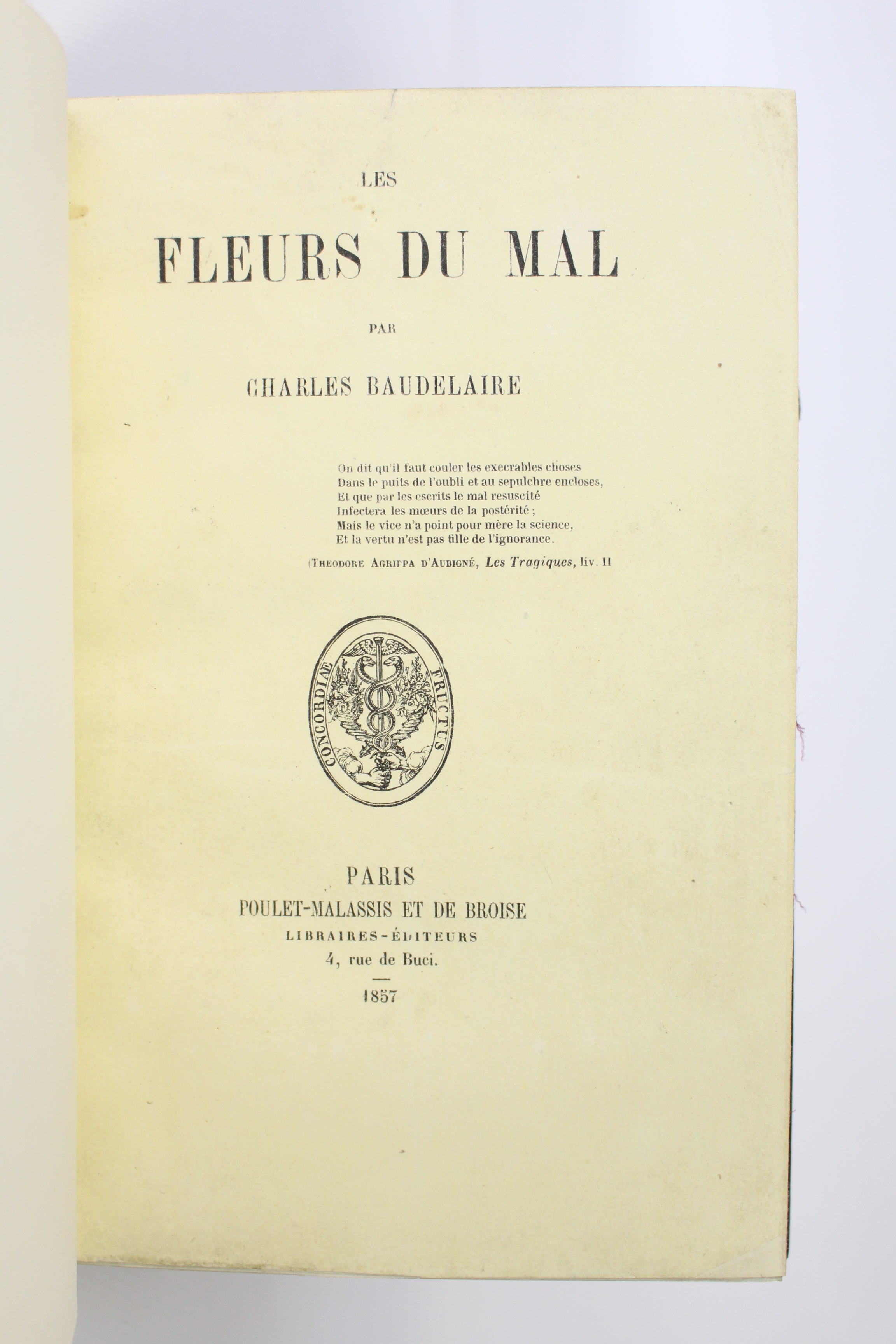 |
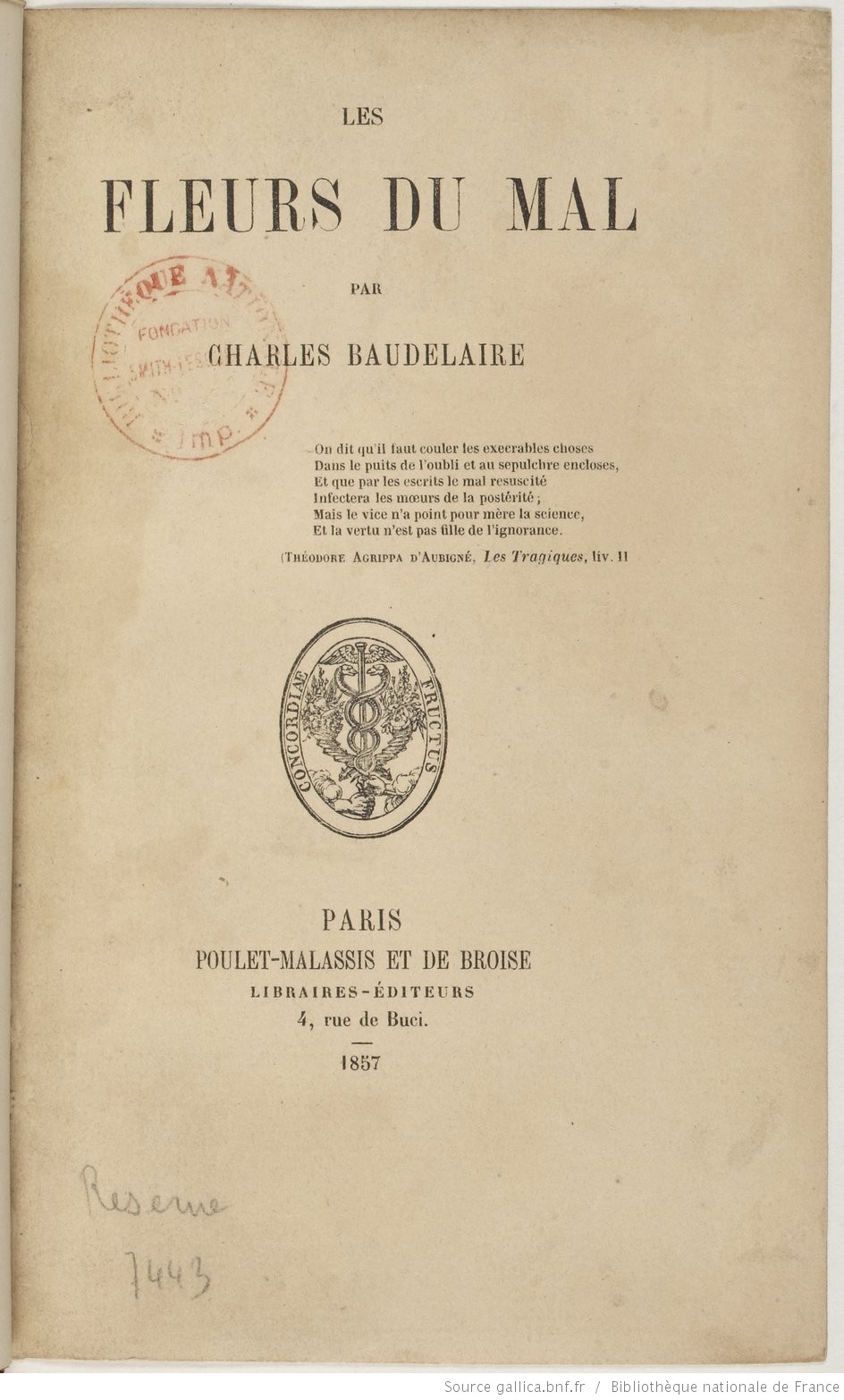 |
exemplary coverage
First draw |
Cover of a copy on
Dutch paper |
The covers have been taken after the body of the book - at least, if one relies on correspondence Baudelaire - it is difficult to draw conclusions from this correlation between the first draft and the third state of the cover.
But this opens conjecture.
Can we assume that the statements of succession is not the one that is believed and that, like the first book, the mistakes were not corrected during the draw but on the contrary, "introduced" by the workers of the printing press, as they were in the body of the text, after the tests?
If it appears obvious that the cover with
the flowers of evil in its ads constitutes a final status, what about the other three?
If the estate is determined only by the assumption that the wrongful release necessarily precedes the "corrected" version, it is surprising that a new tax incentive has to corrections as minimal while adding larger shells like parenthesis not closed on the first course.
Similarly, the issue price on the first condition should be resolved. It seems unlikely that 5 francs was a price set by publishers for pulling power, while the Netherlands was at 6 francs. A free gap for a draw in 1300 and a copy print 20 copies would be least surprising. So if the coverage is 5 francs a first state, it is likely a "pricing error" that would have been corrected by the publisher regardless of other "faults".
Another hypothesis may be advanced:
The order of states is not the one you think. The most rigorous composition of the cover would be the first version (with the only real mistake no close parenthesis) and other mistakes have been added in a second composition made for an annex due to the typographic quality of this blanket. Therefore remains to find but it could be related to the trial of the
Flowers of Evil.
Many questions remain in effect pending about the printing and distribution of this work, yet major in French literature. Thus do we often present the best unredacted copies sold as before "ridiculous surgery" (to quote Baudelaire) operated by Poulet-Malassis about 200 copies still available. In reality, the correspondence of Baudelaire, such as chicken-Malassis reveals that the sale was not nearly as dramatic and most copies were simply removed and "being safe" by the author and editor: "Quickly hide, but hiding any editing; you have to have 900 copies in sheets. - There were still 100 at Lanier; the gentlemen seemed astonished that I voulusse save 50, I put them in a safe place [...]. This leaves 50 to feed Cerberus Justice. "Baudelaire wrote to Poulet-Malassis 11 July 1857. Its editor was immediately executed by distributing its stock at various" accomplices "which Asselineau which he wrote on July 13:" Baudelaire wrote me a letter which I on horseback 'I received yesterday, in which he tells me typing. I expect to see it to believe it, but in any event we have taken our precautions. THE EX. ARE SAFETY and taking advantage of your good will today put the railway ... a box containing 200 ex. sheet I beg you to keep up my next trip ... "
We found no trace back to the sale of such copies in reserve.
Can we link these best non paperback ( "leaf") and the various prints of the cover? A reimposition for this event seems to us a more congruent reason that corrections almost insignificant between said "second" and "third" states.
So be questioned chronological order of the states of the coverage that no concrete evidence to establish with certainty. The correlation between the states of the title page we faced and those of the first cover plate is perhaps a good line of inquiry.
Best hidden are they also all been released from intact sale, despite the ruling banning? The scarcity of copies of the original edition of
Les Fleurs du Mal could let a suspect disappearance, at least in part, of unsold copies and exempt from censorship.
The comprehensive study remains to be done and would require comparing copies autographed by Baudelaire and those he corrected that could possibly date. Similarly, a comparison of blankets Fleurs du mal with other publications of Chicken-Malassis in 1857 would perhaps determine if the type of errors the second course are recurrent or accidental. Finally a more systematic comparison of the false title page of setbacks and securities pages would probably raise the number of state of the notebook and the order of taxation.
However, the scarcity of copies makes the comparison work - essential to this research - more and more difficult to drive.




























